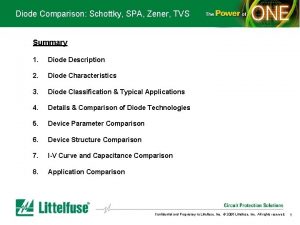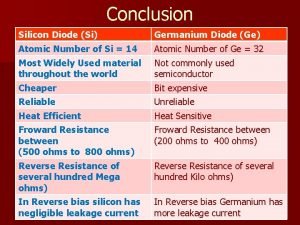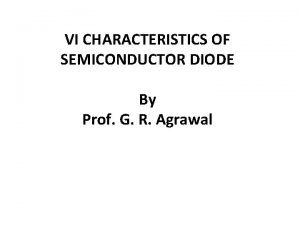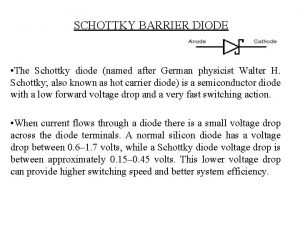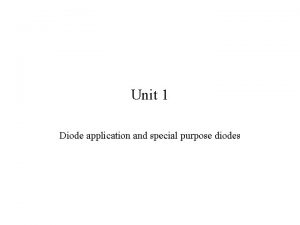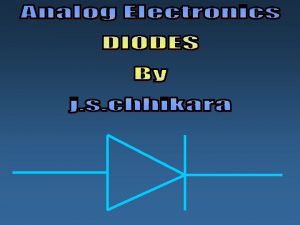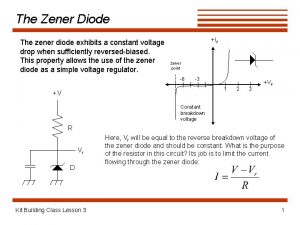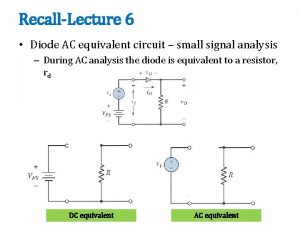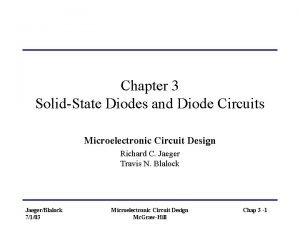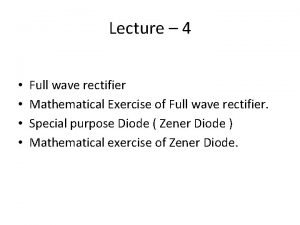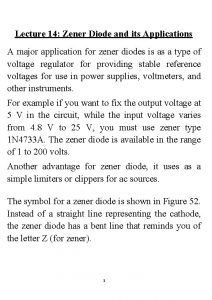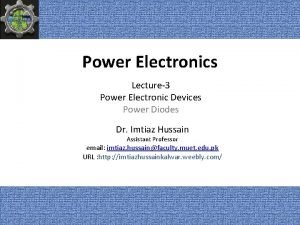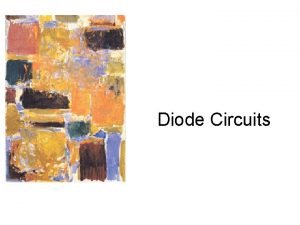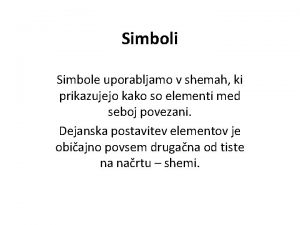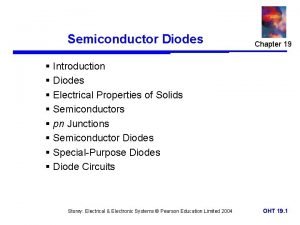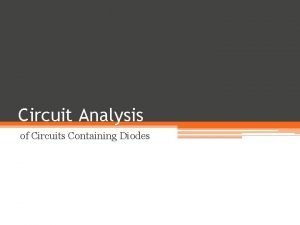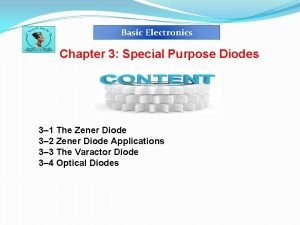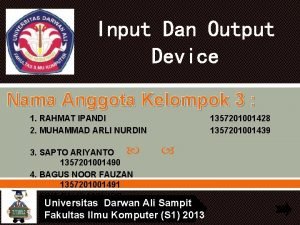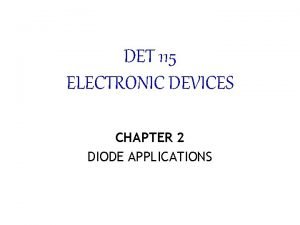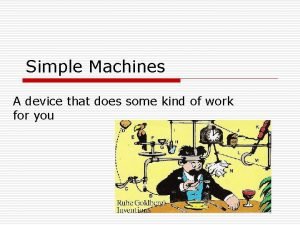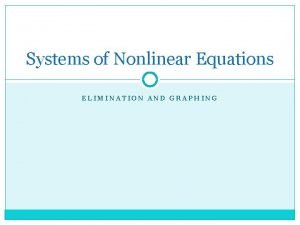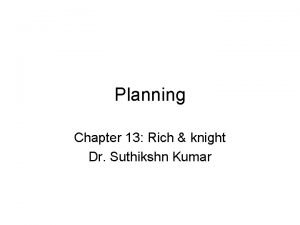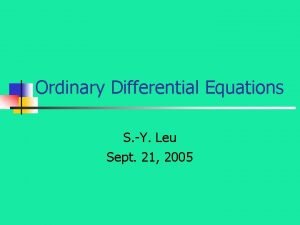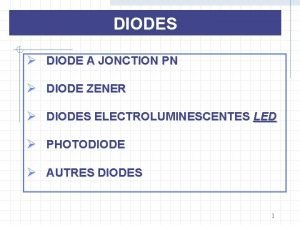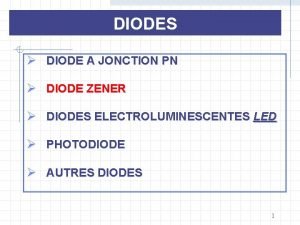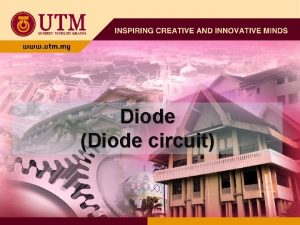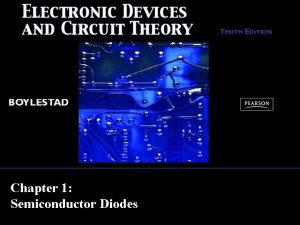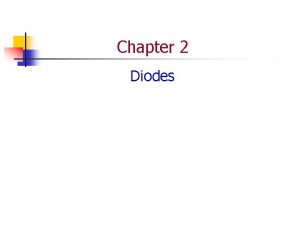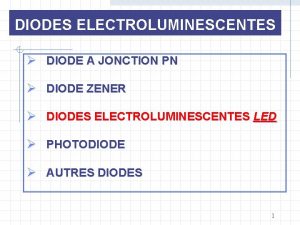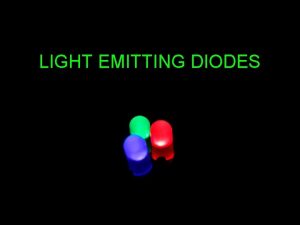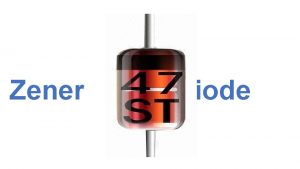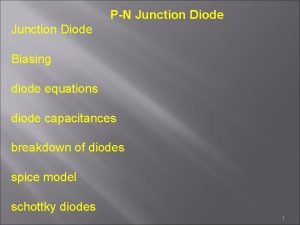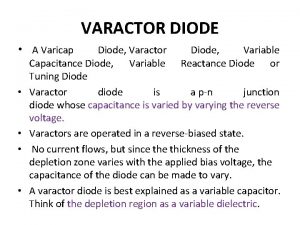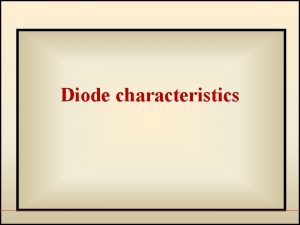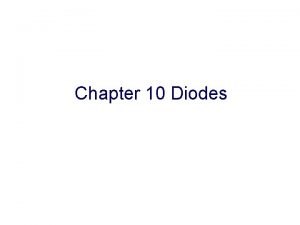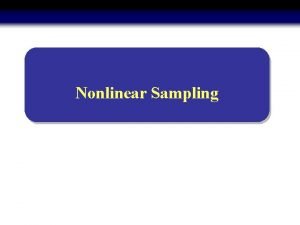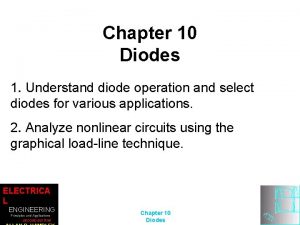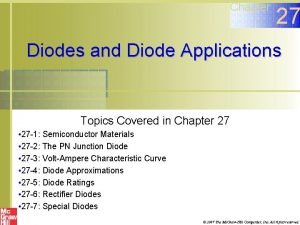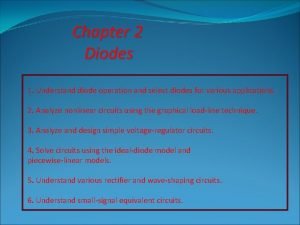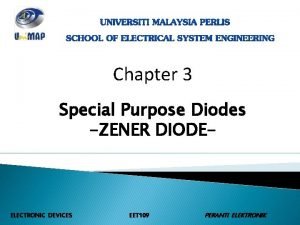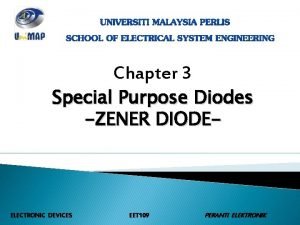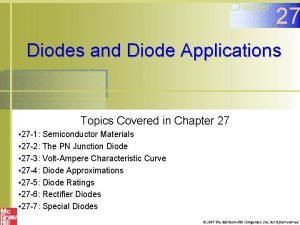Chapter 4 Diodes Diode Simple nonlinear device 2








































- Slides: 40

Chapter 4. Diodes

Diode • Simple non-linear device • 2 terminal device, uni- or bi-directional current flow • Semiconductor • Many types – pn-junction diode – Photo diode – Light emitting diode – Zener diode Copyright 2004 by Oxford University Press, Inc.

Ideal Diode Cut-off Turned-on Copyright 2004 by Oxford University Press, Inc.

Rectifier Copyright 2004 by Oxford University Press, Inc.

Diode Logic Gates “OR” gate v. Y is high if any of v. A, v. B, and v. C is high. Y=A+B+C “AND” gate v. Y is high if all of v. A, v. B, and v. C are high. Y=A • B • C Copyright 2004 by Oxford University Press, Inc.

Given circuit is on the left. Assume the diodes are on (right. ) Copyright 2004 by Oxford University Press, Inc.

Junction Diodes • Semiconductor junction diodes made of silicon. – Forward bias region: v > 0 – Reverse bias region: v < 0 – Breakdown region: v < - VZK Breakdown region Reverse bias region Forward bias region - VZK Copyright 2004 by Oxford University Press, Inc.

Copyright 2004 by Oxford University Press, Inc.

pn Junction of Diode Silicon crystals can be deliberately made impure to create an electrically unstable region. This process is called the “doping. ” For example, boron makes p-type where more holes are present. Phosphorus makes n-type where more electrons are present. Copyright 2004 by Oxford University Press, Inc.

Open Circuit pn Junction Diffusion current Drift current ID = IS The depletion region in the middle creates a barrier voltage. Diode must be biased more than the barrier voltage Copyright to 2004 start by Oxfordconducting. University Press, Inc.

Reverse Biased pn Junction Let I < IS to prevent the breakdown. Injection of additional electrons increases the width of depletion region by combining with more holes and electrons drifted to the middle. → Increase the barrier voltage. Copyright 2004 by Oxford University Press, Inc.

Forward Biased pn Junction I supplies holes to p-region, creating more drift current IS. Depletion region narrows. → Decrease the barrier voltage. Copyright 2004 by Oxford University Press, Inc.

Forward Bias Region Copyright 2004 by Oxford University Press, Inc.

Copyright 2004 by Oxford University Press, Inc.

Reverse Bias Region Copyright 2004 by Oxford University Press, Inc.

Breakdown Region Copyright 2004 by Oxford University Press, Inc.

Exponential Model Graphical Method Numerical Method (Iteration) Copyright 2004 by Oxford University Press, Inc.

Piecewise-Linear Model Copyright 2004 by Oxford University Press, Inc.

Copyright 2004 by Oxford University Press, Inc.

Constant Voltage Drop Model Usually assume VD = 0. 7 V. Ideally, we can also assume VD = 0 V. Copyright 2004 by Oxford University Press, Inc.

No voltage drop. Copyright 2004 by Oxford University Press, Inc.

Small Signal Model Find the DC operating point (i. e. , VD and ID) first using any model. Then, for the small signal, model the diode as a resistor ( whose value equals the inverse of the slop at the Q point. Copyright 2004 by Oxford University Press, Inc.

Copyright 2004 by Oxford University Press, Inc.

Voltage Regulator Copyright 2004 by Oxford University Press, Inc.

Zener Diodes VZ = VZ 0 + r. Z IZ Copyright 2004 by Oxford University Press, Inc.

Zener Diodes as Shunt Regulator Put a Zener diode in parallel with a load. Voltage on the load is limited by the Zener voltage, VZ. Copyright 2004 by Oxford University Press, Inc.

Rectifier Circuits transformer Copyright 2004 by Oxford University Press, Inc.

Half Wave Rectifier Diode model Approximation Copyright 2004 by Oxford University Press, Inc.

Full Wave Rectifier Copyright 2004 by Oxford University Press, Inc.

Bridge Rectifier Copyright 2004 by Oxford University Press, Inc.

Peak Rectifier Copyright 2004 by Oxford University Press, Inc.

Copyright 2004 by Oxford University Press, Inc.

Copyright 2004 by Oxford University Press, Inc.

Precision Half Wave Rectifier Diode in feedback loop of voltage follower. Diode turns on by the open loop gain. → 0. 7 V turn-on threshold not necessary. Copyright 2004 by Oxford University Press, Inc.

Limiting Circuit For circuits with passive elements only, K ≤ 1. Copyright 2004 by Oxford University Press, Inc.

Copyright 2004 by Oxford University Press, Inc.

DC Restorer Initially, the capacitor is charged to a certain voltage with diode on. At this point v. O = 0 V. Now the diode goes off when v. I swings +10 V from -6 V to 4 V. Since there is no discharging path, the capacitor keeps the same voltage; i. e. , v. C remains constant. Thus, the output must also swing +10 V making v. O = 10 V. Copyright 2004 by Oxford University Press, Inc.

DC Restorer with Load R Copyright 2004 by Oxford University Press, Inc.

Clamp Voltage Doubler Peak rectifier During a positive cycle of input, C 1 is charged to Vp. When the input passes the maximum, D 1 cuts off and D 1 turns on. This makes C 2 charged to 2 Vp Copyright 2004 by Oxford University Press, Inc.

Special Types of Diodes • Schottky-Barrier Diode: Forward drop of 0. 3 – 0. 5 V • Varactor: Acts as a voltage variable capacitor • Photodiode: Conducts under the light in the reverse direction • Ligh Emitting Diode: Converts the forward currents to lights. Copyright 2004 by Oxford University Press, Inc.
 Ram input or output device
Ram input or output device Zener vs tvs
Zener vs tvs Conclusion of diode characteristics
Conclusion of diode characteristics Tunnel diode v-i characteristics
Tunnel diode v-i characteristics Diode i-v characteristics
Diode i-v characteristics Diodes
Diodes State any two special purpose diodes
State any two special purpose diodes What are diodes made out of
What are diodes made out of Zener diode oscillator
Zener diode oscillator The ac equivalent of the diode is a resistor
The ac equivalent of the diode is a resistor Et 212
Et 212 Solid state diodes
Solid state diodes Advantage of rectifier
Advantage of rectifier What is zener diode explain its applications
What is zener diode explain its applications Switching characteristics of power diode
Switching characteristics of power diode Practical diode model
Practical diode model Voltmeter simbol
Voltmeter simbol Introduction to diodes
Introduction to diodes Circuit analysis with diodes
Circuit analysis with diodes Special purpose diodes
Special purpose diodes A tagout device is preferable to using a lockout device.
A tagout device is preferable to using a lockout device. Input device dan output device
Input device dan output device Chapter 2: diode applications solutions
Chapter 2: diode applications solutions Future simple
Future simple Present simple past simple future simple
Present simple past simple future simple Present simple present continuous past simple future simple
Present simple present continuous past simple future simple Present simple present continuous past simple
Present simple present continuous past simple Simple past simple present simple future
Simple past simple present simple future Present past future simple continuous exercises
Present past future simple continuous exercises Present tense to past tense
Present tense to past tense Simple present negativo
Simple present negativo Future simple present simple
Future simple present simple Device made up of more than one simple machine
Device made up of more than one simple machine Linear and nonlinear data structure
Linear and nonlinear data structure Linear and nonlinear editing
Linear and nonlinear editing Linear and nonlinear data structure
Linear and nonlinear data structure Graphing systems of nonlinear equations
Graphing systems of nonlinear equations Types of text linear text
Types of text linear text Non linear planning using constraint posting
Non linear planning using constraint posting Contoh gaya berpikir linear dan nonlinear
Contoh gaya berpikir linear dan nonlinear Example of ordinary differential equation
Example of ordinary differential equation

